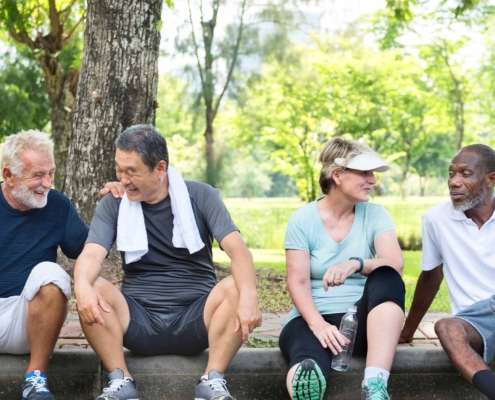
How Indoor Gardens Can Help Seniors Age in Place
Seniors who are aging in place need a supportive, nurturing environment that promotes independence, comfort, and joy. For many in this position, simple daily routines can go a long way in maintaining a strong sense of purpose and well-being. One surprisingly powerful way to enrich life at home is through indoor gardening.
Indoor gardens provide a unique blend of physical activity, cognitive engagement, and emotional uplift—all essential components of wellness for seniors. Explore how indoor gardening supports aging in place and how caregivers, family members, and community providers can use gardening to help loved ones maintain their health and happiness at home.
The Emotional Benefits of Gardening for Seniors
For many aging adults, the golden years bring a mixture of freedom and new challenges. Physical changes, reduced mobility, or the loss of social circles can contribute to feelings of isolation, depression, or anxiety. Supporting a senior’s mental health is just as important as managing physical needs, and gardening is a great way to help
Whether it’s a few potted herbs on a windowsill or a small greenhouse in the sunroom, growing something with care can cultivate more than plants. It can support a person’s emotional health, foster a sense of routine, and bring a bit of nature indoors—especially for those with limited mobility.
Why Gardening Matters
Studies have shown that engaging with nature, even indoors, can reduce stress, improve mood, and boost self-esteem. Watching a plant grow from seed to bloom offers a tangible sense of accomplishment. Nurturing something green and alive gives seniors a daily purpose, a reason to get up and start the day. Even the scent of soil or the sight of fresh greenery can have a calming, grounding effect.
Gardening also encourages mindfulness. Focusing on the rhythm of watering or trimming leaves gently steers attention away from anxiety or sadness and into the present moment. For seniors who may no longer be able to travel or socialize as much as they once did, this can be deeply therapeutic.
Supporting Cognitive Engagement
One of the biggest challenges with aging in place is keeping the mind active and engaged. Memory loss, cognitive decline, and dementia-related conditions are common concerns among older adults and their caregivers. Gardening—especially when done regularly—can become a routine that stimulates mental function in a safe, gentle way.
Tending to an indoor garden requires planning, observation, and decision-making. Repeated small, low-pressure questions like: “Which plants need water today?” “Is that a new sprout or a weed?” “Should the basil be moved to catch more light?” keeps the brain working and reinforces feelings of independence.
In addition, learning about new plants or tracking growth cycles can be a fun and meaningful way to keep curiosity alive. Reading seed packets, watching gardening tutorials, or chatting with a care provider about plant care opens the door for lifelong learning and conversation.
Encouraging Physical Activity
While indoor gardening doesn’t require intense movement, it still supports gentle physical activity—something that’s essential for health and wellness for seniors. From stretching to reach a plant on a shelf to gently transferring soil into a pot, these small motions support joint flexibility, muscle tone, and circulation.
Physical activity, even at light levels, helps regulate blood sugar, support mobility, and improve sleep. For seniors who may be recovering from surgery or managing chronic conditions, low-impact tasks like gardening can be a safe and enjoyable way to stay active without overexertion.
Incorporating an indoor garden into daily life makes it easier to maintain these health benefits, especially when paired with support from a family member or care provider.
Looking for more ways to support the aging adults in your life beyond the garden? Explore everyday tips for meaningful connection and care.
Creating Connection With Caregivers
Indoor gardening can also create a powerful bridge between seniors and the people who care for them. Whether it’s a family member, a friend, or a home care provider, working together on a garden builds trust and companionship. It becomes a shared project—a conversation starter, a way to celebrate growth and progress.
Caregivers can help by setting up garden spaces, offering encouragement, or adapting tasks to meet physical needs. For example, they might lift heavier pots, assist with watering, or keep track of gardening schedules. But the real benefit comes from the moments spent together—laughing over spilled dirt, admiring a bloom, or planning which plant to try next.
These interactions support the senior’s mental and physical health along with the emotional wellness of caregivers, who often find joy and connection in shared creative activities.
How to Start an Indoor Garden for a Senior Loved One
Starting small is key. Indoor gardening doesn’t require a large home or years of experience. Here are some beginner-friendly tips for creating a simple, successful indoor garden:
1. Choose the Right Plants
Low-maintenance plants like pothos, spider plants, herbs (like basil or mint), or succulents are perfect for beginners. These plants are resilient and require minimal care.
2. Prioritize Accessibility
Make sure plants are easy to reach and work with. Tabletop gardens, window boxes, or raised planters on rolling carts can make it easier for seniors to engage without strain.
3. Provide the Right Tools
Lightweight tools with padded grips, self-watering pots, and no-mess potting mats can make the experience smoother and more enjoyable.
4. Incorporate Daily Check-ins
A care provider or family member can set aside time each day to check on the plants together. This supports routine and relationship-building.
5. Keep It Fun
Let the senior choose their favorite herbs, flowers, or vegetables to grow. Maybe they used to love roses or want to try tomatoes on the windowsill. Personal touches add meaning.
Remember, the garden doesn’t have to be perfect. It just needs to be theirs.
How to Pair Gardening With Other Supportive Activities
For many seniors, indoor gardening is one piece of a larger support puzzle. It works best when paired with attentive caregiving, access to resources, and the right home environment. That’s where programs like VA Aid and Attendance benefits can be a tremendous help.
These benefits provide financial support for Veterans and surviving spouses who need assistance with daily living. The added support can make it possible to have help at home from someone who can assist with gardening, meal prep, medication reminders, and more—all of which contribute to aging in place.
Indoor gardening is not just about plants; it’s about building a life that seniors can enjoy. With a strong support system and a few green sprouts on the windowsill, that goal becomes much more achievable.
Keep in Mind
Aging in place means surrounding seniors with the tools, care, and companionship they need to live life on their own terms. Indoor gardening is a simple, joyful practice that supports that goal in meaningful ways, from enhancing senior mental health to encouraging movement and strengthening bonds with caregivers.
No matter how small the garden or modest the home, the act of planting something and watching it grow can be a powerful source of hope, pride, and wellness.
So if you’re looking for new ways to support a senior in your life—or if you’re a senior yourself—consider starting a garden. All it takes is a little soil, some sunlight, and the shared belief that life can bloom at any age.
Let AVCC Help You Create a Thriving Home Environment
At AVCC, we believe aging in place should be safe, joyful, and empowering. Contact us today to learn how we can connect your loved one with compassionate care that makes home feel even more like home.
Share This Post
More Like This
Interesting links
Here are some interesting links for you! Enjoy your stay :)Pages
- About Us
- Account
- Areas We Serve
- Assisted Home Health Care
- AVCC Difference
- AVCC Provider Tools
- Bathing
- Become a Home Care Provider
- Become a Provider
- Become a Provider Now
- Blog
- Companionship
- Contact
- Contracts/Agreements
- Contracts/Agreements
- Fast Track for Providers
- Financial Assistance for Veterans
- For Providers
- Give the Gift of Home Care This Holiday Season
- Home
- Home Care Referrals
- Home Care Services
- HTML Markup
- Laundry
- Light Housekeeping
- Login
- Logout
- Meal Preparation/Feeding
- Members
- Missouri Veterans Benefits
- Password Reset
- Presentations
- Presentations
- Privacy Policy
- Private Duty Home Care
- Providers Tools and Resources
- Referral Resources
- Register
- Resources
- Start the Process
- Thank You
- Thank You – Become a Provider
- Thank You – Home Care Referral
- Thank You for Registering
- Transportation
- User
- VA Aid and Attendance
- VA Aid and Attendance Form
- VA Assisted Living
- VA Benefits for Spouses
- VA Home Health Care
- VA Nursing Home
- Veteran Emergency Assistance
- Veterans Assisted Living
- Veterans Care Coordination
- Veterans Home Care
- Veterans Home Care
- Veterans’ Assistance
- Veterans’ Pension Benefits
- Why American Veterans?



